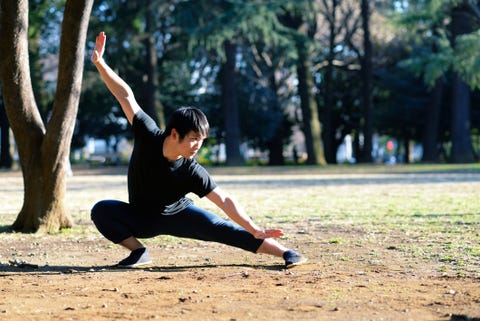When most people think of tai chi (short for “T’ai Chi Ch’üan”) they usually imagine a group of older people moving in slow motion in a public park. But this ancient movement practice is not just for the 65-plus crowd.
Tai chi has many health benefits for people at any age, according to research, like reducing stress, improving strength and balance, and reducing the likelihood of developing chronic diseases such as diabetes, hypertension, and chronic pain. If you want to reap those benefits and master your movements, you’re going to want to slow down and see what tai chi all about.
Where Did Tai Chi Come From?
Tai chi is one of the major branches of Chinese martial arts that dates back thousands of years. With its spiritual roots in Taoism, the practice’s name can be translated to “the ultimate of ultimate”—which is probably more hardcore than you would’ve thought. It consists of exercises designed to bring opposing yin and yang elements of the world into harmony, peace and balance.
For those unfamiliar with the concepts, yin and yang are polar opposites found in nature. Yin represents the more soft, yielding, feminine quality of things while yang represents the more rigid, strong, masculine side. According to tai chi principles, finding harmony between these two opposing forces of nature brings balance and longevity into your life. Does your standard workout do that? Probably not.

electravkGetty Images
Like yin and yang in nature, tai chi aims to brings opposing yet complementary movements together. While many forms of the practice exist, it often combines slow and smooth movements with quick, sharp jabs often seen in fighting or martial arts. It consists of low stances as well as explosive power movements. Also known as “shadow boxing,” tai chi provides both fighting techniques as well as balance and strength training, depending on the goal of of your practice.
“The practical benefits of tai chi are rooted in its unique movement system which emphasizes tension reduction, balance and whole body movement,” says Matt Leve, PT, MSPT, GCFP, a physical therapist and tai chi instructor at Shift Integrative Medicine. Leve often utilizes tai chi in his treatments, since it works with the systems of the body. “Tai chi takes advantage of the elastic nature of the connective tissue system.”
Leve argues that many people’s health concerns are based in patterns of movement that are imbalanced and subsequently generating unnecessary tension and stress in the body. Tai chi helps people reprogram their nervous systems and cultivate what has been best termed as a “coherent elastic body.”
Why Tai Chi Looks Slow
There is a reason for the slow, low movements for which the practice is known. In tai chi, all movement is directed by the mind and driven from the center, or “tantien,” which lies three inches below the navel. Movement is controlled by rotation of the tantien. When that connection is strong, it is smooth, balanced and continuous, even in stillness. Certain styles of tai chi may feature fast and explosive movements at times—but most styles emphasize slow, fluid and intentional movement.
Gaining control of one’s movement and reducing tension with movement can be beneficial for any athlete or workout—even heavy lifting. Leve explains that one of the most significant and beneficial takeaways of tai chi training is the emphasis on developing a relaxed frame. With perseverance, the development of such a frame can help reduce unnecessary tension in the body.
However, Leve reminds us that softness in tai chi does not imply a loss of structure or readiness. A common training error in tai chi is to be too relaxed. You don’t want to be limp like a noodle. This can be dangerous and lead to more stress on the tissues and joints rather than reducing that stress.
How You Can Use Tai Chi In Your Workouts
So how do you apply tai chi movement into your regular workout routine? “With tai chi, power starts from the center, expands in all directions outward and culminates in a blow,” says Leve. “Then it ceases.”
We can apply this in the gym with resistance training. Take a cable pulldown, for example. Applying three basic tai chi principles could improve your performance. Here’s how:
Ready to take on this ancient martial art? Don’t be fooled into thinking it’s easy just because of its slow pace. Sometimes reining in your power with slow, controlled movements is the biggest challenge of all.
Source: Read Full Article
